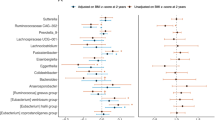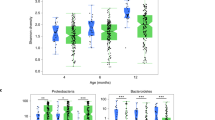Abstract
Background
Growth hormone deficiency(GHD) and idiopathic short stature(ISS) are the primary causes of short stature in children. Animal experiments have revealed a link between growth hormone(GH), gut microbiota and metabolism, however, limited information is available from human trials.
Methods
Fecal samples collected from GHD (n = 36), ISS (n = 32) and healthy control (HC) children(n = 16) were subjected to microbiome (16 S rRNA gene sequencing) and metabolome (nuclear magnetic resonance,NMR) analyses.
Results
GHD, ISS and HC exhibit distinct differences in beta diversity of gut microbiota.In addition, short stature (GHD and ISS) exhibit higher relative abundance of Prevotellaceae_NK3B31_group at genus level compared to HC, whereas Rodentibacter, Rothia, and Pelomonas showed lower abundance. Additionally,Fusobacterium_mortiferum was identified as the characteristic species of GHD. Moreover, glucose metabolism, pyruvate metabolism and pyrimidine metabolism might play significant roles for distinguishing between GHD and normal GH groups (ISS and HC). Furthermore, a disease prediction model based on differential bacteria and metabolites between GHD and ISS exhibited high diagnostic value.
Conclusion
These findings highlight the characteristics of different GH levels on the gut microbiota and metabolism in children, providing novel perspectives for early diagnosis and prognostic treatment of short stature with abnormal GH levels.
Impact
-
The key message of our study is to identify human-relevant gut microbiota and host metabolic patterns that are interfered with growth hormone levels, and to develop biomarker models to identify short stature associated with growth hormone deficiency.
-
We used idiopathic short stature as a control group for growth hormone deficiency, complementing the absence of height as a factor in the existing literature.
-
Our study ultimately hopes to shed new light on the diagnosis and treatment of short stature children associated with growth hormone deficiency.
This is a preview of subscription content, access via your institution
Access options
Subscribe to this journal
Receive 14 print issues and online access
$259.00 per year
only $18.50 per issue
Buy this article
- Purchase on Springer Link
- Instant access to full article PDF
Prices may be subject to local taxes which are calculated during checkout






Similar content being viewed by others
Data availability
The datasets generated during and/or analysed during the current study are available from the corresponding author on reasonable request.
References
Barstow, C. & Rerucha, C. Evaluation of Short and Tall Stature in Children. Am. Fam. Physician 92, 43–50 (2015).
Li, F. et al. Prevalence of Short Stature among Children in China: A Systematic Review. Pediatr. Investig. 5, 140–147 (2021).
Yuen, K. C. J. et al. American Association of Clinical Endocrinologists and American College of Endocrinology Guidelines for Management of Growth Hormone Deficiency in Adults and Patients Transitioning from Pediatric to Adult Care. Endocr. Pr. 25, 1191–1232 (2019).
Chen, W. W. et al. Etiology and genetic diagnosis of short stature in children. Zhongguo Dang Dai Er Ke Za Zhi 21, 381–386 (2019).
Wu, S. et al. A retrospective analysis of patients with short stature in the south of China between 2007 and 2015. Biomed. Res. Int. 2018, 5732694 (2018).
Alatzoglou, K. S., Webb, E. A., Le Tissier, P. & Dattani, M. T. Isolated Growth Hormone Deficiency (Ghd) in Childhood and Adolescence: Recent Advances. Endocr. Rev. 35, 376–432 (2014).
Jensen, E. A. et al. Growth hormone deficiency and excess alter the gut microbiome in adult male mice. Endocrinology 161, bqaa026 (2020).
Yan, J. et al. Gut microbiota Induce Igf-1 and promote bone formation and growth. Proc. Natl Acad. Sci. USA. 113, E7554–E7563 (2016).
Hacioglu, A. et al. Gut Microbiota in Patients with Newly Diagnosed Acromegaly: A Pilot Cross-Sectional Study. Pituitary 24, 600–610 (2021).
Lin, B. et al. Characteristics of Gut Microbiota in Patients with Gh-Secreting Pituitary Adenoma. Microbiol. Spectr. 10, e0042521 (2022).
Huang, C. et al. Gut Microbiota Composition Alteration Analysis and Functional Categorization in Children with Growth Hormone Deficiency. Front. Pediatr. 11, 1133258 (2023).
Xu, R., Zhu, H., Zhang, C., Shen, G. & Feng, J. Metabolomic Analysis Reveals Metabolic Characteristics of Children with Short Stature Caused by Growth Hormone Deficiency. Clin. Sci. (Lond.) 133, 777–788 (2019).
Abd Rahman, S., Schirra, H. J., Lichanska, A. M., Huynh, T. & Leong, G. M. Urine Metabonomic Profiling of a Female Adolescent with Pit-1 Mutation before and During Growth Hormone Therapy: Insights into the Metabolic Effects of Growth Hormone. Growth Horm. IGF Res. 23, 29–36 (2013).
Hoybye, C., Wahlstrom, E., Tollet-Egnell, P. & Norstedt, G. Metabolomics: A Tool for the Diagnosis of Gh Deficiency and for Monitoring Gh Replacement? Endocr. Connect 3, 200–206 (2014).
Savitz, J. et al. Putative Neuroprotective and Neurotoxic Kynurenine Pathway Metabolites Are Associated with Hippocampal and Amygdalar Volumes in Subjects with Major Depressive Disorder. Neuropsychopharmacology 40, 463–471 (2015).
Consensus Guidelines for the Diagnosis and Treatment of Growth Hormone (Gh) Deficiency in Childhood and Adolescence: Summary Statement of the Gh Research Society. Gh Research Society. J Clin Endocrinol Metab 85, 3990–3993 (2000).
Callahan, B. J. et al. Dada2: High-Resolution Sample Inference from Illumina Amplicon Data. Nat. Methods 13, 581–583 (2016).
Bolyen, E. et al. Reproducible, Interactive, Scalable and Extensible Microbiome Data Science Using Qiime 2. Nat. Biotechnol. 37, 852–857 (2019).
Li, L. et al. Characteristics of Gut Microbiome and Its Metabolites, Short-Chain Fatty Acids, in Children with Idiopathic Short Stature. Front Endocrinol. (Lausanne) 13, 890200 (2022).
Kong, F. et al. Gut Microbiota Signatures of Longevity. Curr. Biol. 26, R832–r833 (2016).
Junnila, R. K., List, E. O., Berryman, D. E., Murrey, J. W. & Kopchick, J. J. The Gh/Igf-1 Axis in Ageing and Longevity. Nat. Rev. Endocrinol. 9, 366–376 (2013).
Hu, J. et al. Alterations of the Gut Microbiome in Patients with Pituitary Adenoma. Pathol. Oncol. Res. 28, 1610402 (2022).
Wyse, A. T. S., Santos, Dos, Seminotti, T. M. & Leipnitz, B. G. Insights from Animal Models on the Pathophysiology of Hyperphenylalaninemia: Role of Mitochondrial Dysfunction, Oxidative Stress and Inflammation. Mol. Neurobiol. 58, 2897–2909 (2021).
De Leonibus, C. et al. Growth Hormone Deficiency in Prepubertal Children: Predictive Markers of Cardiovascular Disease. Horm. Res Paediatr. 85, 363–371 (2016).
Acknowledgements
I would like to express my deepest gratitude to all those who contributed to the research. My deepest gratitude goes to Professor Zhihan Yan, Xiaoou Shan, and Hongchang Gao for their invaluable guidance and feedback throughout the entire research process. Their insightful comments and expertise significantly contributed to the improvement of this manuscript. Special thanks to all my fellow classmates who gave me their time in listening to me and helping me work out the difficulties I have encountered in my research. Additionally, I am truly grateful for the continuous support and encouragement received from all those involved in this project. Their commitment to excellence served as a driving force throughout the research process. Without the assistance and contributions of the aforementioned individuals and organizations, this study would not have been possible.
Funding
Our work was supported by grants from the National Natural Science Foundation of China (No. 82100952 and No. 82071902) and Wenzhou Science and Technology Bureau in China (No. Y20220269).
Author information
Authors and Affiliations
Contributions
Lan Li, Yu Wang, Yinyin Huang, Yi Lu, Weiyi Wang, and Xian Chen have made substantial contributions to conception and design, acquisition of data, or analysis and interpretation of data; Lan Li drafted the article and Yi Lu, Zhihan Yan, Hongchang Gao, Xiaoou Shan revised it critically for important intellectual content.
Corresponding authors
Ethics declarations
Competing interests
The authors declare no competing interests.
Consent to participate
The parents of all participants provided written informed consent upon receiving a written explanation of the study’s purpose before enrollment.
Additional information
Publisher’s note Springer Nature remains neutral with regard to jurisdictional claims in published maps and institutional affiliations.
Rights and permissions
Springer Nature or its licensor (e.g. a society or other partner) holds exclusive rights to this article under a publishing agreement with the author(s) or other rightsholder(s); author self-archiving of the accepted manuscript version of this article is solely governed by the terms of such publishing agreement and applicable law.
About this article
Cite this article
Li, L., Wang, Y., Huang, Y. et al. Impact of different growth hormone levels on gut microbiota and metabolism in short stature. Pediatr Res (2024). https://doi.org/10.1038/s41390-024-03140-4
Received:
Revised:
Accepted:
Published:
DOI: https://doi.org/10.1038/s41390-024-03140-4



